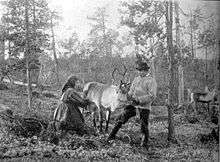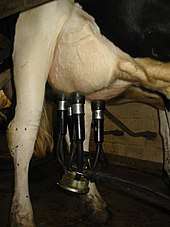Milking


Milking is the act of removing milk from the mammary glands of cattle, water buffalo, goats, sheep and more rarely camels, horses and donkeys. Milking may be done by hand or by machine, and requires the animal to be currently or recently pregnant. The milker may refer either to the animal that produces the milk or the person who milks said animal.[1]
Hand milking
Hand milking is performed by massaging and pulling down on the teats of the udder, squirting the milk into a bucket. Two main methods are used:
- The top of the teat is pinched shut between finger and thumb, trapping milk in the lower part, which is then squeezed by the other fingers, squirting the milk out through the hole in the tip of the teat.
- The top of the teat is pinched shut by the fingers and thumb, which are then slid down the teat, pushing the milk towards the bottom.
Machine milking

Most milking in the developed world is done using milking machines. Teat cups are attached to the cow's teats, and then the cups alternate between vacuum and normal air pressure to extract the milk. The milk is filtered and cooled before being added to a large bulk tank of milk for storage.
Today there exist fully automatic milking machines which give a cow the freedom to choose when to be milked, allowing for a larger amount of milk to be obtained more efficiently.[2]
Venom milking
Milking is also used by extension to describe the removal of venom from snakes and spiders, for the production of antivenom.
See also
External links
| Wikimedia Commons has media related to Milking. |
- (in English) MilkAcademy (for more applicable information about milking equipment and dairy farming)
- ↑ "Definition of MILKER". www.merriam-webster.com. Retrieved 11 November 2016.
- ↑ "Robotic Milking Machine". YouTube.